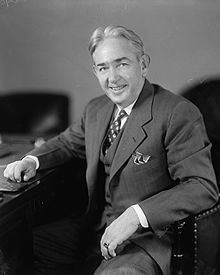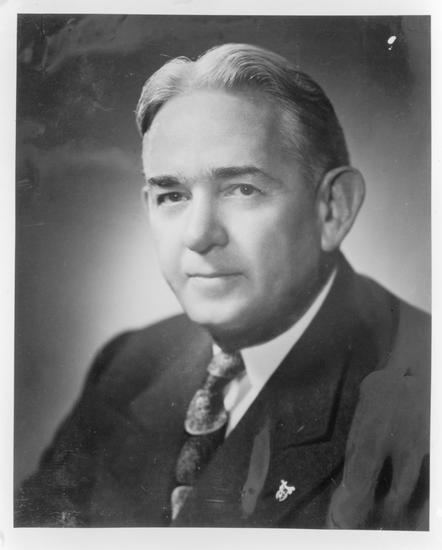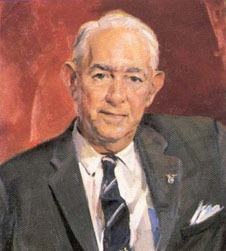Preceded by Position established Preceded by Thomas B. Stanley Lieutenant Allie E. S. Stephens Party Democratic Party | Preceded by Ambrose O\'Connell Role Judge Nominated by John F. Kennedy Name James Almond, Battles and wars World War I | |
 | ||
Nominated by Legislative reassignment Died April 15, 1986, Richmond, Virginia, United States Spouse Josephine Minter (m. 1925) Education Virginia Tech, University of Virginia School of Law | ||
Succeeded by Haldane Robert Mayer | ||
James Lindsay Almond Jr. (June 15, 1898 – April 15, 1986) was a United States federal judge and politician. He served as the 58th Governor of Virginia from 1958 until 1962, and was the last governor of Virginia to have been born in the 19th century.
Contents
Early life

Almond was born in Charlottesville, Virginia and raised in Orange County, Virginia. Almond attended Virginia Tech and served as a private in the Students Army Training Corps in 1917 and 1918 in World War I. Then, he taught school in Locust Grove, Orange County, Virginia. He served as a high school principal and earned an LL.B. from the University of Virginia School of Law in 1923.
Political career

Almond was assistant commonwealth attorney of Roanoke, Virginia from 1930 to 1933 and was a state court judge to the Hustings Court of Roanoke from 1933 to 1945. He was then elected to the US House of Representatives from Virginia's 6th congressional district, serving in the 79th and 80th Congresses.
Almond resigned his Congressional seat in 1948, when he was elected Attorney General of Virginia. He argued the state's case for segregation of public schools before the United States Supreme Court in the case of Davis v. County School Board of Prince Edward County, which was consolidated with Brown v. Board of Education. Virginia lost both in 1954 and 1955.
Although not a favorite of Senator Harry F. Byrd, Almond had demonstrated loyalty to the Byrd Organization as well as the national ticket and racial segregation. Byrd had been offended by Almond's endorsement of Martin Hutchinson for the Federal Trade Commission and had refused to endorse Almond for governor in 1953 so Thomas B. Stanley was nominated and ultimately elected. By 1956, Byrd had announced the organization's policy of massive resistance, and as attorney-general, Almond had defended what became known as the Stanley plan/despite doubts about its constitutionality. In 1957, Almond resigned as attorney general (and Stanley appointed Kenneth Cartwright Patty to fill the rest of the term) and announced early for the Democratic nomination for governor. Almond refused Byrd's offer of a position on the Virginia Supreme Court conditioned upon his endorsing Byrd's preferred nominee, Garland Gray, a stalwart segregationalist. Gray then withdrew from the Democratic primary, and Almond easily won the Democratic nomination for Governor of Virginia. His Republican opponent, Theodore Roosevelt Dalton, would have allowed racial integration of the public schools pursuant to court orders. Almond offered segregationist rhetoric in most locations and won election as Virginia's governor a month after President Dwight Eisenhower sent troops to enforce a desegregation order in Little Rock, Arkansas, over the opposition of its governor, Orval Faubus.
Almond took office in January 1958 for a volatile term that ended in 1962. On January 19, 1959, the Virginia Supreme Court and a three judge federal panel both found the Stanley Plan unconstitutional. Almond initially protested but soon called a special legislative session and announced (to Byrd's fury and that of James J. Kilpatrick, among others) that he would not resist the federal court orders. He allowed public schools in Arlington and Norfolk to desegregate peacefully by to court orders on February 5, 1959. Heeding the advice of several moderates within his own party, including Senator Mosby Perrow Jr., Almond realized that opposition to desegregation was ultimately futile, as the state continued to lose in the courts. In April 1959, Almond and his lieutenant governor, Allie Edward Stakes Stephens, helped Perrow and Stuart B. Carter of Fincastle, Virginia narrowly secure passage of bills which allowed localities to determine whether to desegregate their schools.
Schools in Albemarle and Warren Counties opened and followed desegregation orders, but the schools in Prince Edward County remained closed until 1963, and the tuition assistance program that supported segregation academies remained in effect until 1968 when the US Supreme Court decided Green v. County School Board of New Kent County. Thus, except for Prince Edward County, massive resistance had been transformed into passive resistance against school desegregation.
However, Harry F. Byrd Jr. and longtime Byrd lieutenant E. Blackburn Moore defeated Almonds' request for a sales tax in 1960, which some saw as retaliation for allowing school desegregation. Stephens resigned just before year end to run for governor (following Almond's early declaration example). However, the Byrd Organization slated Albertis Harrison (the attorney general who had supported segregation and litigation against the NAACP) as their candidate. Stephens lost badly in the 1961 Democratic primary (which ended his elected career), and Byrd loyalist Mills Godwin defeated moderate Armistead Boothe for lieutenant governor, but the machine's vote totals were lower than previously. Both Harrison and Godwin won election in November, with Robert Young Button being elected attorney general.
Federal judicial career
In 1960, Almond had campaigned for President John F. Kennedy, who nominated him to be a judge on the United States Court of Customs and Patent Appeals (CCPA). Byrd blocked his initial confirmation so Kennedy gave Almond a recess appointment. President Kennedy sent another appointment, and Almond was confirmed 164 days later (more than a year after the first appointment, which Byrd had said he would not block) when Senator Byrd eventually missed a floor session. However, Byrd's vindictiveness toward Almond eventually undermined the Byrd Organization.
Judge Almond took senior status on March 1, 1973. By operation of the Federal Courts Improvement Act of 1982, the CCPA was eliminated, and Judge Almond was reassigned to the United States Court of Appeals for the Federal Circuit as a senior judge until his death, in 1986.
Elections
Personal life
Almond married Josephine Katherine Minter in 1925. He was a Lutheran and taught a men's bible class. He was a 32nd degree Mason, a Shriner, and a member of Alpha Kappa Psi and Omicron Delta Kappa.
Death
Almond died in 1986 in Richmond, Virginia. He is buried in Evergreen Burial Park in Roanoke, Virginia.
